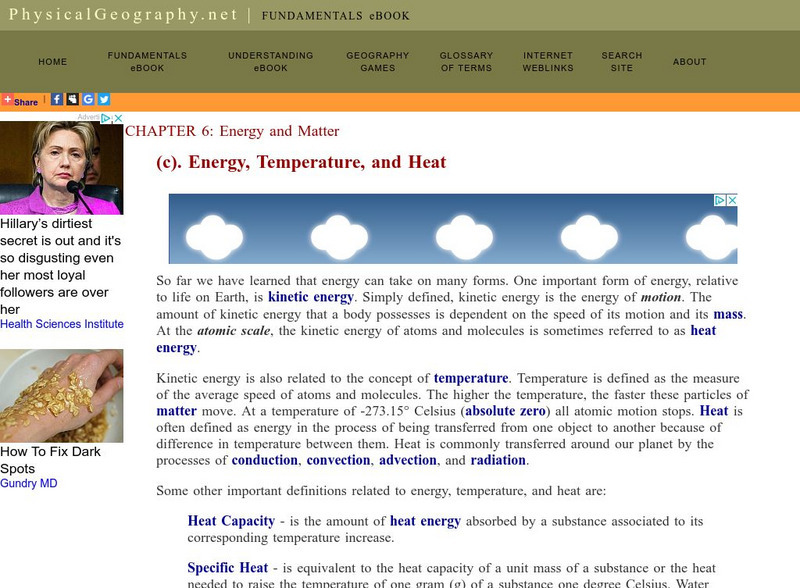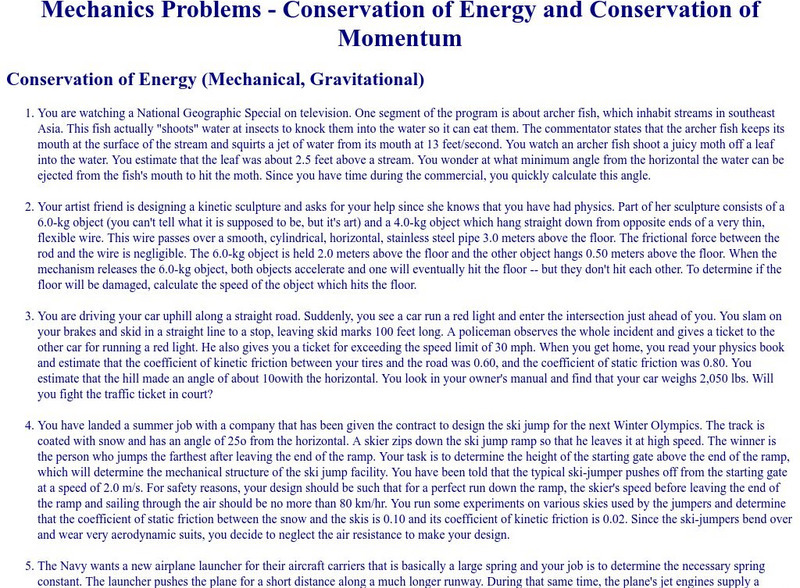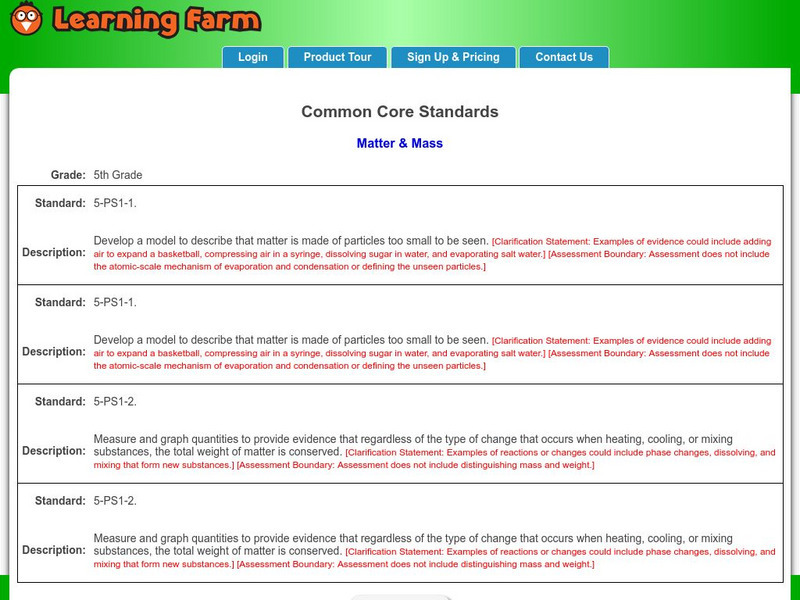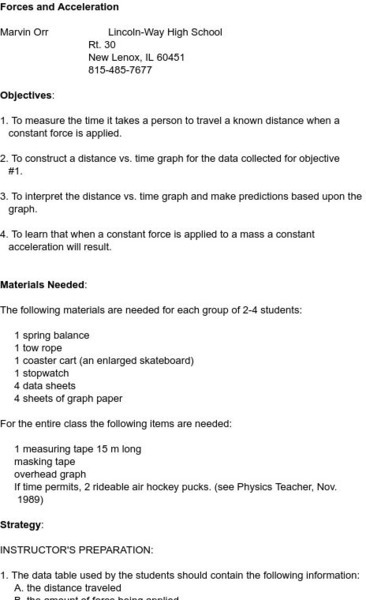Ducksters
Ducksters: Physics for Kids: Potential Energy
Kids learn about potential energy in the science of physics. The energy of position and state can be calculated using mass, gravity, and height. The standard unit is the joule. How it is different from kinetic energy.
Learn AP Physics
Learn Ap Physics: Physics B: Modern Physics
A site dedicated to help students prepare for the AP Physics B test. This specific site reviews Modern Physics including photons, photoelectric effect, atomic energy levels, The Michelson-Morley experiment, The Lorentz Transformation,...
Other
Fund. Of Phys. Geography/energy, Temperature, and Heat
A page describing (in part) the distinction between energy, temperature and heat. Includes a graphic illustrating the quantity of energy needed to transform water between various states. Methods of thermal energy transfer (convection,...
Other
Characteristics of Energy and Matter
A lengthy page from the Fundamentals of Physical Geography site. Energy is distinguished from matter, and the different forms of energy are identified and discussed. Four types of heat transfer (convection, advection, conduction,...
Other
Laws of Thermodynamics
A page from the Fundamentals of Physical Geography site. Identifies, describes and elaborates upon the first, second, and third laws of thermodynamics.
ClassFlow
Class Flow: Matter 2nd Grade
[Free Registration/Login Required] Interactive flipchart teaching the states of matter for a 2nd grade classroom containing four topics with several lessons in each one. The topics covered are: matter, solids, liquids, and gases....
ClassFlow
Class Flow: Measure Relationships
[Free Registration/Login Required] The teacher will use this lesson plan flipchart to review length, mass and capacity.
Math Is Fun
Math Is Fun: Metric Mass (Weight)
Grams, kilograms and tonnes are explained, and real life examples are given for each.
PBS
Pbs Teachers: Boats Afloat Experiment
Estimate how many pennies a flatboat made of aluminum foil will hold, then test your hypothesis.
ClassFlow
Class Flow: Introduction to Matter
[Free Registration/Login Required] This flipchart is a basic introduction to the properties of matter, mass, and weight. It discusses the physical properties of objects.
University of Minnesota
University of Minnesota: Conservation of Momentum
This site provides a set of four Physics problems dealing with the conservation of momentum principle.
Cornell University
Cornell University: Astronomy: Electromagnetism and Charge
This site from Cornell University provides a very short, very telling comparison of matter and charge. This is a good site to check out on the subject, with a chart diagram to help with further information.
National Council of Teachers of Mathematics
The Math Forum: Mass vs. Weight
This site gives an explanation that distinguishes mass from weight. It distinguishes between the two types of mass (inertial and gravitational), and gives the equations for computing both.
Other
Ask Numbers: Measurement Conversion Calculators and Charts
What kind of unit conversion would you like to do? This site will allow you to do a multitude of conversions. Just click on the specific measurement you are needing to convert. It also provides a history of measurements and a chart of...
Learning Farm
Learning Farm: Matter and Mass
Practice what you know about matter and mass. Choose between test mode and game mode to answer questions pertinent to matter and mass.
Department of Defense
Do Dea: Resistance Proportional to Velocity
Resistance to forward movement will be proportional to the velocity of the object. That relationship can be expressed by an equation that you can learn about on this page. Great review for the AP Calculus test!
Educaplus (Jesús Peñas Cano)
Educaplus: Dinamicas De Dos Masas Que Cuelgan De Una Polea [In Spanish]
This is a short demonstration to see the dynamics of two masses connected by a pulley.
Doina Popovici
Math Play: 3rd Grade Halloween Math Game
Be ready to smash the monsters by solving problems involving volume, mass, and time in this math game.
Calculator Soup
Calculator Soup: Momentum Calculator
Choose a calculation for momentum p, mass m or velocity v. Enter the other two values and the calculator will solve for the third in the selected units.
Calculator Soup
Calculator Soup: Density Calculator
Choose a calculation for density p, mass m or Volume V. Enter the other two values and the calculator will solve for the third in the selected units.
Science and Mathematics Initiative for Learning Enhancement (SMILE)
Smile: Lab Work Forces & Acceleration
The Illinois Institute of Technology provides this site. The site contains a graphing activity which illustrates that a constant force exerted upon an object results in constant acceleration. Rolling carts and stopwatches are used to...
Science and Mathematics Initiative for Learning Enhancement (SMILE)
Smile: Colliding Spheres
This lab activity from the Illinois Institute of Technology lets students investigate the impact of collisions upon the velocity and momentum of the colliding objects. Requires understanding of vectors.
PBS
Pbs Teachers: Weightlessness Experiment
Demonstrate how water and a cup fall at the same rate of speed.
NASA
Nasa: Beginner's Guide to Aerodynamics
This site from NASA discusses application of Newton's first law of motion to airplane motion. Includes a graphic and an accompanying explanation.

















![Educaplus: Dinamicas De Dos Masas Que Cuelgan De Una Polea [In Spanish] Interactive Educaplus: Dinamicas De Dos Masas Que Cuelgan De Una Polea [In Spanish] Interactive](https://content.lessonplanet.com/knovation/original/408860-61c268f12e47634bb4f222f816b18bf7.jpg?1661771905)



